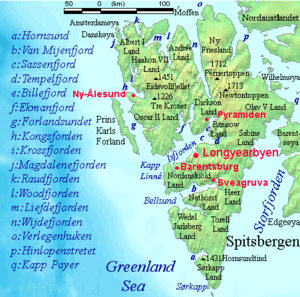
Bellsund
Encyclopedia


Spitsbergen
Spitsbergen is the largest and only permanently populated island of the Svalbard archipelago in Norway. Constituting the western-most bulk of the archipelago, it borders the Arctic Ocean, the Norwegian Sea and the Greenland Sea...
, part of the Svalbard
Svalbard
Svalbard is an archipelago in the Arctic, constituting the northernmost part of Norway. It is located north of mainland Europe, midway between mainland Norway and the North Pole. The group of islands range from 74° to 81° north latitude , and from 10° to 35° east longitude. Spitsbergen is the...
archipelago.
History
Bellsund was first seen by William Barents in 1596. He simply referred to it as Inwyck (inlet). In 1610 Jonas PooleJonas Poole
Jonas Poole was an early 17th century English explorer, sealer, and whaler. Although Henry Hudson has often been dubbed the "father of English whaling," Poole, who's 1610 voyage led to the establishment of the English whaling trade, deserves the title.-Voyages to Bear Island, 1604-1609:He served...
explored Bellsund, giving the fjord the name it retains to this day. He named it after a nearby bell-shaped mountain. In 1612 the Dutchman Willem Cornelisz. van Muyden
Willem Cornelisz. van Muyden
Willem Cornelisz. van Muyden was an early 17th century mariner. He is known in The Netherlands as De Eerste Walvisvanger...
was the first to attempt to catch whales here, but he wasn't very successful as he didn't have any Basque whalemen among his crew. In 1613, Basque
Basque Country (historical territory)
The Basque Country is the name given to the home of the Basque people in the western Pyrenees that spans the border between France and Spain on the Atlantic coast....
, Dutch
Netherlands
The Netherlands is a constituent country of the Kingdom of the Netherlands, located mainly in North-West Europe and with several islands in the Caribbean. Mainland Netherlands borders the North Sea to the north and west, Belgium to the south, and Germany to the east, and shares maritime borders...
, and French
France
The French Republic , The French Republic , The French Republic , (commonly known as France , is a unitary semi-presidential republic in Western Europe with several overseas territories and islands located on other continents and in the Indian, Pacific, and Atlantic oceans. Metropolitan France...
whaling vessels resorted to Bellsund, but were either ordered away by armed English
England
England is a country that is part of the United Kingdom. It shares land borders with Scotland to the north and Wales to the west; the Irish Sea is to the north west, the Celtic Sea to the south west, with the North Sea to the east and the English Channel to the south separating it from continental...
vessels or forced to pay a fine of some sort.
In 1614 the Dutch agreed to give Bellsund to the English, but only for one season. In 1615 the Dutch built the first semi-permanent whaling station in Spitsbergen at the mouth of Schoonhoven (Recherchefjorden
Recherchefjorden
Recherchefjorden is a small fjord on the south side of Bellsund, Spitsbergen.-History:The fjord is named after the French cruiser La Recherche, which visited Spitsbergen in 1838 and 1839. Before being renamed, it had been called Schoonhaven by the Dutch since the early 17th century. The English...
), on the south side of Bellsund. It was appropriated by the English the following year. In 1626 this station was damaged by York
York
York is a walled city, situated at the confluence of the Rivers Ouse and Foss in North Yorkshire, England. The city has a rich heritage and has provided the backdrop to major political events throughout much of its two millennia of existence...
and Hull
Kingston upon Hull
Kingston upon Hull , usually referred to as Hull, is a city and unitary authority area in the ceremonial county of the East Riding of Yorkshire, England. It stands on the River Hull at its junction with the Humber estuary, 25 miles inland from the North Sea. Hull has a resident population of...
whalers, who then sailed to their whaling station in Midterhukhamna, just across the entrance of Van Keulenfjorden
Van Keulenfjorden
Van Keulenfjorden is a 30km long fjord on the west coast of Spitsbergen separting Nathorst Land to the north and Wedel Jarlsberg Land to the south. Van Keulenfjorden is separated from Bellsund by Forsbladodden in the north and Richardodden to the south....
. Here they were found by the heavily-armed flagship of the London whaling fleet, the Hercules, under admiral William Goodlad. A two-hour battle ensued, resulting in defeat for the Hull and York fleet and their expulsion from Spitsbergen. Hull continued to send whaling vessels to occupy this station for the next 25 years, while the English as a whole probably resorted to Bellsund at least until the late 1650s.

